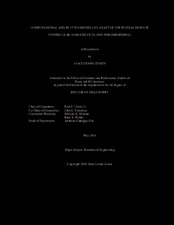| dc.description.abstract | Heart failure is consistently one of the top causes of death each year worldwide. Ventricular assist devices (VADs) have become common alternatives for patients with severe, end-stage heart failure; VADs take a significant load off of the heart and aid in perfusion of downstream organs by pumping blood from either or both ventricles to their corresponding great vessel. External VAD controllers track specific pump parameters such as estimated flow rates and device power consumption.
Suspected thrombosis is a common clinical adverse event in VAD therapy. In this condition, a VAD controller will indicate periods of low flow or high power; clinicians suspect that this indicates that a thrombus is increasing friction between the moving components and/or obstructing the inflow or outflow. Suspected thrombosis typically results in device exchange surgery. A pathology evaluation of the explanted VAD can reveal if materials inside the pump at explant originated within or upstream from the device.
VADs explanted after years of support often had an actively organizing thrombus along the inflow cannula or protruding from the insertion site in the ventricle. We hypothesize that these thrombi form over time due to regions of stagnation and recirculation of the blood in the ventricle. Moreover, as the VAD continues to take a load off of the heart, we suspect that the remodeling of the heart will change the flow dynamics within the ventricle and cause thrombi to dislodge and travel into the pump. As thrombi of different age and size pass into the device, we hypothesize that each VAD model will demonstrate a particular change in flow rate in response to the thrombus.
Through the research in this dissertation, we have investigated these phenomena by creating a computational model of the ventricular insertion site before and after cardiac remodeling occurs, and an in vitro model that displays VAD response to thromboembolic particles. These computational and in vitro models show that over time, the presence of the VAD inflow cannula within the heart will change the potential for thrombi to form around the device, dislodge, and travel into the VAD, and result in changes of pump flow rate.
This research is beneficial to VAD manufacturers and clinicians in the development of devices that will limit opportunity for thromboembolic complications, and provide direction for treatment of patients currently undergoing VAD therapy. | en |


